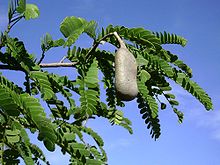The fruit has a fleshy, juicy, acidulous-pulp. It is mature when the flesh is coloured brown or reddish-brown. The tamarinds of Asia have longer pods containing six to 12 seeds, whereas African and West Indian varieties have short pods containing one to six seeds. The seeds are somewhat flattened, and glossy brown.
The tamarind is best described as sweet and sour in taste, and is high in tartaric acid, sugar, B vitamins and, oddly for a fruit, calcium.
As a tropical species, it is frost sensitive. The pinnate leaves with opposite leaflets give a billowing effect in the wind. Tamarind timber consists of hard, dark red heartwood and softer, yellowish sapwood.[citation needed]
It is harvested by pulling the pod from its stalk. A mature tree may be capable of producing up to 175 kg (386 lb) of fruit per year. Veneer grafting, shield (T or inverted T) budding, and air layeringmay be used to propagate desirable selections. Such trees will usually fruit within three to four years if provided optimum growing conditions.
Etymology
The name derives from Arabic tamr-hindī, meaning "date of India". Several early medieval herbalists and physicians wrote tamar indi, medieval Latin use was tamarindus, and Marco Polo wrote of tamarandi.
In Colombia, the Dominican Republic, Mexico, Puerto Rico, Venezuela and throughout the Lusosphere, it is called tamarindo. In the Caribbean, tamarind is sometimes called tamón.[4] Tamarind (Tamarindus indica) is sometimes confused with "Manila tamarind" (Pithecellobium dulce). While in the same taxonomic family Fabaceae, Manila tamarind is a different plant native to Mexico and known locally as guamúchil.
Fore more info
https://www.hort.purdue.edu/newcrop/morton/tamarind.html
Sincerely
Rozzy
Queen of Shea
Facebook.com/queenofsheabutter
Tyra Beta Beautytainer
Facebook.com/fierceyourface1
The Natural Life https://www.facebook.com/groups/Rozzynaturalweightlosssupportgroup/








No comments:
Post a Comment